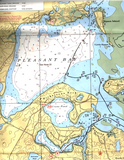
Pleasant Bay is located on Cape Cod, Massachusetts. We moor in the South Orleans section of Pleasant Bay. Orleans is on the outer cape, just north of Chatham. Sections of the local charts are available as images elsewhere on this web site.
Nauset Beach is a barrier beach that is as little as a few hundred feet wide, and not very high. Nauset separates Pleasant Bay from the Atlantic Ocean. The predominant gradient wind and/or sea breezes from Nantucket Sound can cross Chattam and produce a southwest wind. Often stronger and very common is a southeast or east wind that may be an ocean breeze off the Atlantic. Typical wind strength is 15-20 knots. From spring through July, 10-15 knots is on the light side and 20-25 is on the heavy side but both are common. Passing weather systems often bring the heaviest sustained wind strengths usually strongest from the east and northeast. August brings lighter winds, more typically 10-15 knots. Winds under 5 knots are uncommon except in August and generally only in the morning or well after sunset.
Winds in Pleasant Bay may be considerably stronger than what inland lake sailors or other protected water sailors typically experience. Many inland and protected water sailors choose not to sail in wind strengths that we routinely sail in (20-25 knots, sometimes more).
There are also other parts of the country and other parts of the world that routinely have stronger conditions than these. Some that are famous among sailors are the San Fransisco Bay area, the western coast of South Africa, and the western coast of Australia. We certainly hold no monopoly on stiff breezes and hold no records either.

Exiting Pleasant Bay raises significant safety concerns. A shallow channel leads to Chatham Break which provides access to the Atlantic Ocean. The shoaling, currents, and possible rough conditions in Chatham Break can be dealt with safely. The possibility of an unexpected change in weather after exiting the Break poses the greatest hazard.
In the event of an unexpected change for the worse in weather, conditions in Chatham Break can become sufficiently hazardous that it is no longer safely passable by small craft. If caught outside the break, the alternates are to risk passing through the break, or stay outside and ride out the heavy weather, or sail south, then through Polluck's Rip or Great Round Shoal Channel to Nantucket, or sail north and around the north tip of Cape Cod to Provincetown. Provincetown is a safer sail in adverse conditions than Nantucket, but is aout 50 miles away. Nantucket is 30 miles away if Pollucks Rip remains passable, 40 miles if conditions require the longer route through Great Round Shoal Channel.
As a safety precaution we have been intentionally sailing in heavy conditions in the safety of Pleasant Bay to determine the limits of the vessel and crew and to improve upon them.
We have no intentions of sailing in adverse conditions on the open ocean if we can help it. However, we frequently experience beautiful sunny sailing days in which the weather predictions include the possibility of scattered thundershowers. On the ocean and even occasionally in Pleasant Bay scattered thundershowers can bring near-gail or gail force squals. Thankfully these tend to be short lived.
Improvements intended specifically to improve heavy air sailing include the boom vang, sail fairlead track moved forward, 60% headsail, and second reef in the main sail. All have been tried out in 20-25 knot conditions and in gusts to 35 knots, except the 60% headsail. The second reef in the main and a small reduction in the 110% headsail have proven sufficient to make it quite easy sailing in sustain 25 knots with gusts over 30 knots. Sailing with a single reef with sustained winds reported to be 25 knots (but not measured on the handheld meter) and 5 foot waves made for a rough beat upwind, a wild ride but fun but was too much sail.
The availability of a second reef and smaller headsail give us the confidence that we can handle stronger conditions than the 25-30 knots that was difficult to sail in before these changes and very difficult when we first got the boat. For safety reasons, we will continue avoid venturing out of Pleasant Bay whenever there is a possibility of adverse conditions until such time as we have confirmed that we can comfortably sail in gail force winds though at this point the possibility of 25 knots (the threshhold for small craft advisiories) no longer needs to be considered adverse conditions.
Over the course of any given season we are given a few opportunities to test this within Pleasant Bay. Sustained winds of over 25 knots generally occur before mid-July or in the fall. One of these seasons we'll have a need to try the 60% jib but we haven't so far.